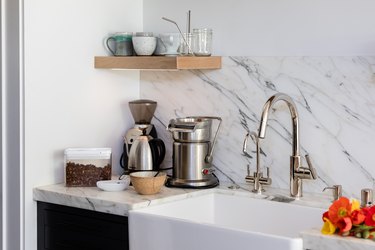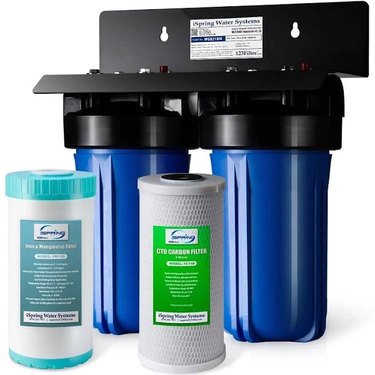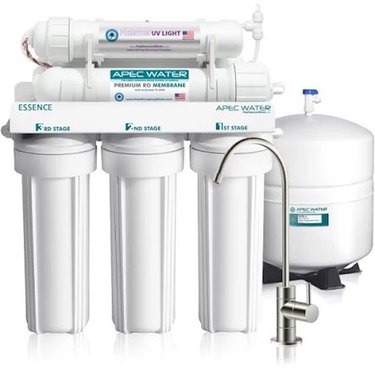Water filter systems are designed to clean contaminants and other funky-tasting things out of our drinking water, but that doesn't mean that the systems themselves don't also need to be cleaned. Performing regular maintenance and cleaning keeps the system working efficiently to provide clean water to your family. Replacing filters is the most common maintenance task, but the specifics can vary based on the type of water filtration system.
Clean and Maintain a Reverse Osmosis System
Video of the Day
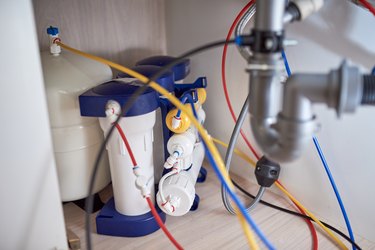
Reverse osmosis systems push water through a semipermeable membrane, leaving the impurities on one side and the clean water on the other side. It slowly filters water and keeps it in a storage tank until you need it. A reverse osmosis system removes a variety of contaminants from water.
Video of the Day
The system typically has between three and five filtration stages, including filters and a semipermeable membrane. Replacing those filters and the membrane is the primary maintenance task for these systems. If you don't change the filters or membrane soon enough, your system will likely slow down and filter less water. It can completely stop filtering water if the filters become clogged and are no longer useful.
Reverse Osmosis Filter Changes
The length of time a filter lasts depends largely on how much water you use and how dirty the tap water is coming into your home. Filters that have to work harder will need to be replaced sooner. A filter replacement schedule includes:
- Pre-filter: This stage comes before the membrane to remove sediment, such as silt, sand, and rust. Change it every six to nine months to prevent it from getting clogged.
- Carbon filter: Some systems have a carbon filter next, which handles things that make your water taste or smell bad, such as chlorine. The replacement schedule is every six to 12 months.
- Reverse osmosis membrane: The membrane removes most of the remaining contaminants, including water-borne pathogens, lead, and fluoride. It only needs to be replaced once every two to three years.
- Carbon filter: Many systems have another carbon filter after the membrane to polish the water and improve the taste. Like the other filters, this one usually needs to be replaced every six to 12 months.
Reverse Osmosis Cleaning
The system should also be cleaned and sanitized about once per year. You can do the job yourself or hire a water treatment professional to do it for you. Always check the instructions for your model to determine system-specific steps.
In general, you'll need to shut off the water supply, remove all of the filters and the membrane, and depressurize your system. This gives you a chance to scrub the inside of the housing. Unscented household bleach or a special reverse osmosis sanitizing product goes into the housing for the first filter with all of the filters removed before turning on the water to let it fill.
Let it sit for 30 minutes. Then, turn on your faucet connected to the reverse osmosis system and let it run until you no longer smell bleach, usually about five minutes. Turn off the water supply to the reverse osmosis system and turn on the faucet until you completely empty the water. Fill it and drain it a second time before replacing all of the filters and the membrane and using the system again.
Clean and Maintain an Activated Carbon System
Activated carbon filters are available as whole-house filters or point-of-use filters, such as under-sink filters or showerhead filters. They use a process called adsorption, which is different than absorption. In adsorption, the contaminants stick to the surface of the filter, creating a film of particles rather than absorbing into something. The large surface and porous construction make a carbon filter effective at removing harmful contaminants.
Activated Carbon Maintenance
Larger whole-house activated carbon water filters need to be replaced every six months to a year. Smaller filters, such as those in showerheads or water pitchers, often need to be replaced every month or two depending on how much use they get. Remove the filter, clean the housing, and put the new filter in place. Avoid going longer than a year, as the old filter can contaminate water instead of cleaning it. A dirty carbon filter might allow the contaminants that have been collected to break off from the filter and go back into your water.
Clean and Maintain a UV Light System
This type of filtration system uses special UV lights to disrupt the genetic code of DNA of the microorganisms in the water so they can no longer replicate and infect other organisms. It doesn't use any chemicals and is effective in getting rid of 99.9 percent of the harmful microorganisms in your water, such as E. coli. The UV light carries the weight of this water filtration system, so you need to change it regularly.
UV Light Maintenance
Even though the light won't burn out, it will solarize, which means the intensity decreases. After about 9,000 hours, or roughly a year, the light wave intensity drops to about 60 percent of its original power. Change the light once per year or based on the schedule recommended by the owner's manual.
Your system also has a UV quartz sleeve to protect the UV light. Buildup from minerals, sediment, and other contaminants in the water can create a clouding effect, which reduces the effectiveness of the UV light. Cleaning it yearly when you change the light is the easiest option since you need to remove the lamp. Using a soft cloth that won't scratch the sleeve, wipe it with vinegar to remove the buildup.
Clean and Maintain an Ion Exchange System
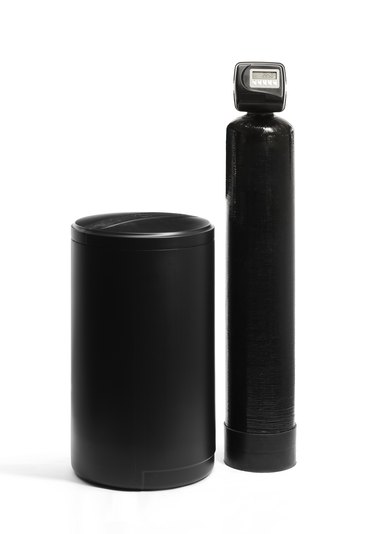
An ion exchange system is a type of water softener that primarily removes magnesium and calcium from the water. It can be used alone or with other filtration systems to remove more contaminants. The system uses resin beads, which are coated with sodium ions from the water softener salt you add to the system. As the water moves through, the sodium ions swap places with the magnesium and calcium ions that make the water hard.
Ion Exchange Maintenance
Ion exchange systems require regular maintenance because you have to add more salt when it runs low. The frequency depends on how hard the water is and how much water you use. Check the salt level every few weeks to see if it needs to be refilled and pay attention to the typical timing to get into a schedule. When you add salt, look for a salt bridge, which is a hard crust of salt that keeps the salt separated from the water, and also look for salt sludge, which is recrystallized salt that creates a sludge in the bottom. These need to be broken up and cleaned out as soon as you notice them.
Using resin bed cleaner once or twice per year helps keep the resin beads clean. Follow the instructions, which typically involve pouring it in the brine tank tube. You'll also want to clean the brine tank once a year or more often if it has a lot of buildup. To clean the brine tank, wait until the salt level is low. Then, remove and discard the remaining salt and scrub the tank with soapy water. After rinsing, you can follow up with a few gallons of water and a quarter cup of bleach, letting it sit for 15 minutes before draining and rinsing it.
The system does a regular regeneration process to remove the magnesium and calcium ions from the resin beads, but the beads need to be replaced occasionally. This process only needs to be done every seven years or so. It's best left to a professional and will usually cost between $100 and $300.
